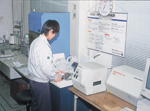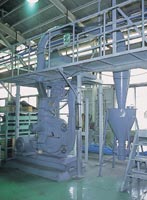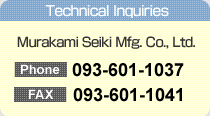To satisfy the requirements for the optimal milling, classification, screening, conveyance and feeding of powders, the Powder Engineering Center carries out tests on a variety of equipment used for these processes. These tests serve to help you select the right equipment for the job, and also to confirm the capabilities of each device. We use our many years of testing experience to propose the most appropriate tests and select the best equipment. Processing services as well as equipment sales are available.—please contact us for more information about this. |
 |
1. Flow of Testing
2. Test Equipment
To best meet the needs of our customers, we conduct tests and measurements on the following equipment.

(1) Milling machines
The milling machines use agitators based on Uras vibrator technology to turn a milling medium inside a drum to process material.
| Model | Description | Max. Processing Capacity |
Average Particle Size after Milling |
|---|---|---|---|
| YAMP-6S YAMP-4J |
This is a batch milling machine that uses a Uras vibrator. The material and medium are loaded into the pot, and then milled by vibration. It is suited to micro-milling of the order of 1 μm. | 0.9 L/batch | Up to several μm |
| YAMT-20SNVB | This is a two-drum vertical continuous milling machine. | 150 kg/h | Several μm to 3 mm |
| YAMH-25FN | This is a single-drum vertical continuous milling machine. | 300 kg/h | Several μm to 3 mm |
| YAMT-20JNVD | This is a two-drum vertical continuous milling machine. Porcelain is affixed as the drum linings. | 100 kg/h | Several μm to 3 mm |
| YAMT-100FNVF | This is a two-drum vertical continuous milling machine. | 3000 kg/h | Several μm to 3 mm |
For details on the equipment, refer to the product pages.
Applications: Ferrite, iron oxide, coke, limestone, silica sand, slag, etc.
(2) Classifiers
These are machines that use an airstream or vortex to separate grains that fall on either side of a set classification diameter, with the smaller grains going into one group and the larger grains going into another.
| Model | Description | Processing Capacity | Classification Diameter |
|---|---|---|---|
| YACA-132H | This is a horizontal classifier. It is capable of precise classification of materials with small classification diameters. | 20 to 200 kg/h | 2.5 to 15 μm |
| YACA-400H | This is a horizontal classifier. It is capable of very precise classification of materials with strong stickiness. | 400 to 2500 kg/h | 6 to 50 μm |
| YACA-400HS | This is a horizontal classifier. It is capable of even more precise classification than the 400H. | 150 to 1000 kg/h | 3.5 to 50 μm |
| YACA-400V | This is a vertical classifier. It has a large processing capacity and is suited to rough classification. | 300 to 2000 kg/h | 8 to 100 μm |
For details on the equipment, refer to the product pages.
Applications: Lime, talc, quartz, silica sand, starch, cement, flour, toner, solder powder, etc.
(3) Separators (jumping screens)
This screening machine uses the wave motion of a urethane mat to flip a material upwards. This action causes conglomerated material to break up and disperse, and allows more efficient screening.
| Model | Description | Max. Processing Capacity |
Screening Diameter |
|---|---|---|---|
| LF-0.5-2.52/8ED | A unique wave motion prevents clogging of highly sticky materials and powders with high moisture content. |
3000 kg/h | 0.3 to 40 mm |
For details on the equipment, refer to the product pages.
Applications: Iron ore raw materials, sand, waste materials, waste plastics, slag, lime, gypsum, etc.
(4) Transport devices
These are plug flow conveyance type of air conveyors.
They can transport various raw materials up to a size of 25 mm.
| Model | Conveying Pipe Diameter |
Conveying Distance |
Conveying Capacity |
|---|---|---|---|
| VPP75F/50 | 50 mm | 32 m | 75 L/batch |
| VPP250F/100 | 100 mm | 85 m | 250 L/batch |
Applications: Grain, pellets, sand, glass, gypsum, iron powder, dust, etc.
(5) Measuring equipment
We measure the characteristics of powders both before and after testing with the following devices. Please consult with us for details regarding our various powder measurement services.
| Measurement | Measuring Method/Device | Measuring Range |
|---|---|---|
| Grain size | <Laser Diffraction and Scattering Method> Wet Microtrack HRA |
0.1 to 700 μm |
| <Screening Method> Standard screening (Rotating and tapping shaker) |
45 μm to 26.5 mm | |
| Wet screening | 20 μm to 4 mm | |
| Air jet sieve | 25 to 297 μm | |
| Specific surface area | Shimadzu specific surface area meter SS100 | Powder specific surface areas from 0.5 to 100 μm |
| Powder characteristics | Powder tester | |
| Moisture | Constant-temperature drying oven | |
| Infrared moisture meter |


